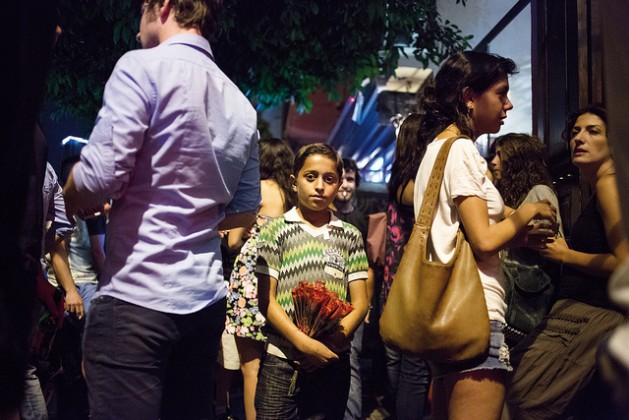By Kanya D’Almeida
UNITED NATIONS, Jul 3 2015 (IPS) – In a conflict that has claimed over 220,000 lives and injured a further 840,000 people as of January 2015, it is sometimes hard to see beyond the death toll.
What started as a confrontation between pro-democracy activists and the entrenched dictatorship of President Bashar al-Assad in 2011, Syria’s civil war is today one of the world’s most bitter conflicts, involving over four separate armed groups and touching numerous other countries in the region.
Aboudi, 12, spends his evenings selling flowers outside Beirut’s bars. His parents are stuck in his war-torn hometown Aleppo in Syria. Credit: Sam Tarling/IPS
“I feel responsible for my family. I feel like I’m still a child and would love to go back to school, but my only option is to work hard to put food on the table for my family.” — Ahmed, a 12-year-old Syrian refugee in Jordan
With millions on the brink of starvation and displaced Syrians now representing the largest refugee population in the world, after Palestinians, scores of lesser-known war-related atrocities are jostling for space in the headlines.
On Jul. 2, the United Nations Children’s Fund (UNICEF) and Save the Children released a joint report highlighting one of the hidden impacts of the Syrian crisis – a rise in child labour throughout the region.
In a press release issued in Jordan’s capital, Amman, Thursday, the agencies warned, “Syria’s children are paying a heavy price for the world’s failure to put an end to the conflict.
“The report shows that inside Syria, children are now contributing to the family income in more than three quarters of surveyed households, In Jordan, close to half of all Syrian refugee children are now the joint or sole family breadwinners in surveyed households, while in some parts of Lebanon, children as young as six years old are reportedly working.”
“The most vulnerable of all working children are those involved in armed conflict, sexual exploitation and illicit activities including organised begging and child trafficking,” the release stated.
Before the outbreak of war four years ago, Syria was considered a middle-income country, providing its people a decent standard of living and boasting a literacy rate of 90 percent, according to UNICEF data.
By the middle of 2015, however, four in five Syrians were living below the poverty line and 7.6 million were classified as internally displaced persons (IDPs).
With whole cities and towns emptied of residents, businesses and industries have collapsed, sending unemployment rates soaring from 14.9 percent in 2011 to 57.7 percent today.
The U.N. Refugee Agency estimates that about 3.3 million people have fled the country altogether and now live in camps or makeshift shelters in neighbouring states. Women and children comprise over half the refugee population.
The vast majority of those who remain inside Syria – over 64.7 percent – are classified as living in “extreme poverty”, unable to meet the most basic food or sanitary needs.
Thus, experts say, it comes as no surprise that children are becoming breadwinners, taking to the streets and selling their labour in a range of industries to help keep their families alive.
As 12-year-old Ahmed, a Syrian refugee in Jordan, pointed out in interviews with UNICEF, “I feel responsible for my family. I feel like I’m still a child and would love to go back to school, but my only option is to work hard to put food on the table for my family.”
Entitled ‘Small Hands, Heavy Burden: How the Syrian Conflict is Driving More Children into the Workforce’, the report notes that an estimated 2.7 million Syrian children are currently out of school.
With few education opportunities and dwindling humanitarian rations, these children now either comprise, or are at risk of joining the ranks of, a veritable army of child workers.
“In Jordan, for example a majority of working children in host communities work six or seven days a week; one-third work more than eight hours a day,” the report noted. “Their daily income is between four and seven dollars.”
Quite aside from representing an irreversible interruption to their education, cognitive development, and – almost certainly – limiting their chances of securing better jobs later in life – the child labour epidemic is harming young people’s bodies.
Save the Children estimates that “Around 75 percent of working children in the Za’atari refugee camp in Jordan reported health problems; almost 40 percent reported an injury, illness or poor health; and 35.8 percent of children working in Lebanon’s Bekaa Valley are unable to read or write.”
In this climate of conflict, with the specter of hunger haunting countless families, every industry is considered fair game.
In the Bekaa Valley, for instance, landowners who used to pay a daily wage of 10 dollars to migrant agricultural workers now pay kids four dollars a day, often for performing the same tasks alongside their adult counterparts.
In urban centers, garages, workshops and construction sites are “popular” employers, with 10-year-old Syrian boys hired on a full-time basis to do carpentry, metal work or motor repairs in cities across Lebanon.
Street work represents one of the most dangerous occupations for children, with a recent survey of two major Lebanese cities identifying over 1,500 child street-workers, of whom 73 percent were Syrian refugees.
These kids earn an average of 11 dollars a day, either begging or hawking, while illicit activities like prostitution could earn a small child up to 36 dollars in a single working day.
UNICEF says child labour “represents one of the key challenges to the fulfillment of the ‘No Lost Generation’ initiative”, launched in 2013 with the aim of putting child rights and children’s education at the centre of the humanitarian response to the Syrian crisis.
Edited by Kitty Stapp
Licensed from Inter Press Service




 © 2025 All Rights Reserved
© 2025 All Rights Reserved